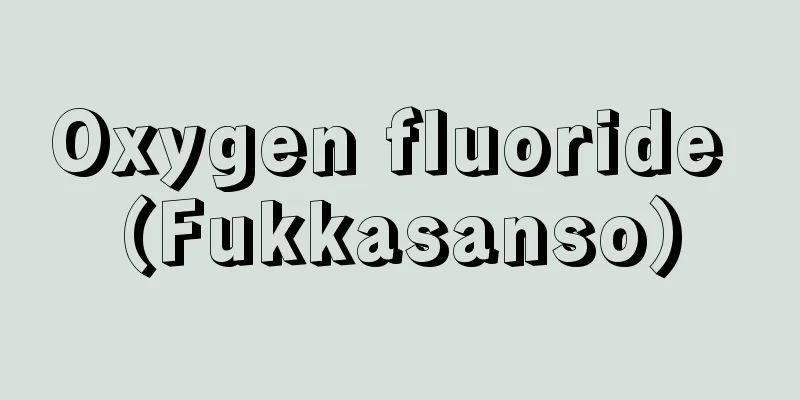Explosion - explosion

|
A phenomenon in which a container bursts due to the sudden build-up or release of pressure, or a gas expands rapidly, producing a loud explosion or destructive effects. It is most often caused by a rapid increase in volume resulting from a rapid chemical reaction such as decomposition or combustion. The best-known examples are the explosions of trinitrotoluene (TNT), nitroglycerin, and dynamite. Although igniting a thin layer of nitroglycerin only results in slow combustion, rapid heating causes it to decompose and produce a large amount of gas. 4C3H5N3O9― → [Yamazaki Akira] DeflagrationThis refers to the process in which the heat of reaction of one molecule is transferred to the next molecule, causing them to heat up and decompose, as occurs when firewood or coal burns. Gunpowder explosions in guns are an example of this, and the propagation speed (explosion velocity) is often less than 300 meters per second. [Yamazaki Akira] ExplosionThis is when the propagation speed of the explosion is much greater than the speed of sound in the medium, producing a strong shock wave. In the case of TNT, the detonation speed is 6,700 meters per second with a specific gravity of 1.59. Pyrophoric mercury has a detonation speed of 5,400 meters per second (specific gravity of 4.5), and lead azide has a detonation speed of 5,300 meters per second (specific gravity of 4.6). Generally, detonation is when the detonation speed is 1,500 meters per second or more. In this case, the processes of flame propagation and combustion are integrated and cannot be distinguished. When a detonation occurs, the gas pressure reaches several thousand atmospheres and the temperature reaches several thousand degrees Celsius. When a mixed gas detonation occurs, the range is limited to a certain area, but hydrocarbons such as acetylene, methane, and propane tend to detonate over a fairly wide range of mixtures. Examples of this are gas explosions in coal mines (caused by methane) and the recent frequent explosions caused by city gas and propane gas in apartments and condominiums. Mixtures of hydrogen and oxygen also tend to detonate over a wide range. In particular, detonation gas with two volumes of hydrogen and one volume of oxygen causes a violent explosion, so it is called hydrogen detonation gas. [Yamazaki Akira] Dust explosionEven solid substances that are unlikely to burn or explode normally can explode when mixed with air in a fine powder state due to ignition or static electricity. This is called a dust explosion. Coal dust explosions in coal mines are well known, but flour warehouses are also prone to dust explosions during fires. Charcoal, aluminum, tobacco, feed, rice bran, powdered milk, and even cocoa, sulfur powder, and detergent can explode. In this case, the possibility of explosion is dangerous when the particle size is 700 micrometers or less, and extremely dangerous when it is 100 micrometers or less. The explosion limit is lower as the particle size becomes smaller, but in most cases it is between 10 and 50 milligrams per cubic meter. The minimum ignition energy is between 10 and 80 millijoules (2.5 to 20 millicalories). [Yamazaki Akira] Chain ExplosionExplosive gas mixtures can explode at temperatures much lower than those that produce so-called thermal explosions. This is due to a chain reaction, and chain explosions are often distinguished from normal thermal explosions (although recent research suggests that thermal explosions may also result from a different chain reaction, so the distinction may be purely phenomenological). As an example, let's take the mechanism of the chain reaction between hydrogen and oxygen (below is the equation that shows the process). [Chain reaction between hydrogen and oxygen] The pressure of the reactant gas is important for such a chain reaction to occur. If the pressure is too low, there is less opportunity for collisions between atoms and radicals in the reaction intermediates, but if the pressure is too high, radicals will recombine with each other, breaking the chain. Therefore, there are upper and lower limits for the occurrence of a chain reaction. In the chain reaction of hydrogen and oxygen, there are explosion limits as shown in . In this case, at the second limit, the chain stops due to the production of less reactive HO2 . This HO2 collides with the vessel wall and is removed from the reaction system. At higher pressures, the reaction again proceeds slowly, but at even higher temperatures there is another explosion limit, and above this limit a thermal explosion occurs. [Yamazaki Akira] Thermal ExplosionWhen an explosion occurs in a mixture of an oxidizer and a fuel, such as a gas mixture of oxygen and hydrogen, due to electrical discharge, heating, or sudden compression, if the reaction rate is high, the rate at which heat is generated by the reaction becomes faster than the rate at which the heat is dissipated to the surroundings, and the accumulation of reaction heat causes an explosion. This is called a thermal explosion. [Yamazaki Akira] Use of explosionsExplosive substances are certainly dangerous, but if used by experts for appropriate purposes, they are not something to be avoided. Dynamite and other substances have become widely used because the instability of nitroglycerin has been overcome. One interesting recent application has been the successful attempt to use lead azide and other substances to explode bladder stones, thereby shattering and expelling them. This is an example of the use of a controlled explosion. Research is also being conducted into the use of explosive energy to generate electricity. [Yamazaki Akira] "Combustion and Explosions" by Toshizo Chitani (1957, Maki Shoten) " Safety Engineering Lectures 2: Explosions" edited by the Japan Society of Safety Engineering (1983, Kaibundo Publishing) [References] | | |The diagram shows the upper and lower limits of the hydrogen-oxygen chain reaction . Explosive limits (figure) Source: Shogakukan Encyclopedia Nipponica About Encyclopedia Nipponica Information | Legend |
|
圧力の急激な発生あるいは解放のために容器が破裂したり、または気体の急激な膨張によって爆発音や破壊作用を伴う現象。この原因は、分解や燃焼などの化学反応が急激に進行した結果の体積の急激な増加であることがほとんどである。もっともよく知られた例としてはトリニトロトルエン(TNT)やニトログリセリン、ダイナマイトなどの爆発がある。ニトログリセリンは、薄い層に点火しても緩やかに燃焼がおこるだけであるが、急激に加熱すると分解がおこり、大量の気体を生じる。 4C3H5N3O9―→ [山崎 昶] 爆燃薪(まき)や石炭が燃える場合のように、一つの分子の反応熱が順次隣の分子に伝わって加熱、分解がおこることをさす。銃砲内での火薬の爆発などはこれであり、伝播(でんぱ)の速度(爆速)は毎秒300メートル以下のものが多い。 [山崎 昶] 爆轟爆発の伝播速度が媒質中の音速よりもずっと大きく、強い衝撃波を生じる場合である。TNTの場合、爆速は装填(そうてん)比重1.59で毎秒6700メートルである。雷汞(らいこう)は毎秒5400メートル(装填比重4.5)、アジ化鉛も毎秒5300メートル(装填比重4.6)の爆速をもっている。通常、爆速が毎秒1500メートル以上の場合を爆轟とよぶ。この場合は伝火と燃焼のプロセスは一体化されてしまい区別することができない。 爆轟がおこると、気体の圧力は数千気圧、温度も数千℃になる。混合気体で爆轟がおこる際、その範囲はある一定の領域に限られるが、アセチレンやメタン、プロパンなどの炭化水素は、かなり広い混合範囲にわたって爆轟をおこしやすい。炭坑内のガス爆発(メタンによる)あるいは最近頻発するアパートやマンション等の都市ガスやプロパンガスによる爆発はこの例である。水素と酸素の混合気体も広い範囲で爆轟しやすい。とくに水素二容、酸素一容の爆鳴気は激しい爆発をおこすので、水素爆鳴気とよばれている。 [山崎 昶] 粉塵爆発普通には燃焼や爆発などをおこしそうにない固体物質でも、細かい粉末状態で空気と混合している場合、点火や静電気の火花などで爆発することは珍しくない。これを粉塵爆発(ふんじんばくはつ)という。炭坑の炭塵爆発などは著名であるが、小麦粉の倉庫なども火災時に粉塵爆発をおこしやすい。木炭やアルミニウム、タバコ、飼料や米糠(こめぬか)、粉ミルク、果てはココアや硫黄(いおう)粉末、洗剤のようなものまで爆発をおこす。この場合、爆発の可能性は、粒子の大きさが700マイクロメートル以下だと危険となり、100マイクロメートル以下では著しい危険性をはらむ。爆発限界は粒径が小さいほど低いが、多くの場合1立方メートル当り10~50ミリグラムである。最小発火エネルギーは10~80ミリジュール(2.5~20ミリカロリー)である。 [山崎 昶] 連鎖爆発爆発性の混合気体は、いわゆる熱爆発よりもずっと低温なのに爆発をおこすことがある。これは連鎖反応のためであり、連鎖爆発といって通常の熱爆発と区別しておくことが多い(もっとも最近の研究結果では、熱爆発もまた異なった連鎖反応の結果おこるらしいので、区別は単に現象面だけのものとなるかもしれない)。 例として、水素と酸素の連鎖反応の機構を取り上げてみる(以下はそのプロセスを示す式である)。 〔水素と酸素の連鎖反応〕 このような連鎖反応がおこるには、反応気体の圧力が重要である。圧力が低すぎれば、反応中間体の原子やラジカルの衝突の機会は減るが、高すぎると、ラジカルどうしの再結合などがおこって連鎖は切れる。したがって連鎖反応のおこる上限と下限ができることになる。 水素と酸素の連鎖反応においてはのような爆発限界がある。この場合、第二限界のところでは、反応性に乏しいHO2の生成のために連鎖が止まる。このHO2は器壁に衝突して反応系から除かれてしまう。これより高圧ではまた反応は緩やかに進行するようになるが、さらに高温ではもう一つの爆発限界があり、これから上では熱爆発がおこる。 [山崎 昶] 熱爆発酸化剤と燃料との混合物、たとえば酸素と水素の混合気体に放電、加熱、急激な圧縮などで爆発がおこるとき、反応速度が大きくなると、反応によって熱が発生する速度のほうが、周囲に熱を逸散させる速度より大となり、反応熱の蓄積がおこって爆発となる。これを熱爆発という。 [山崎 昶] 爆発の利用爆発性物質は確かに危険なものであるが、専門家が用途に応じて利用すれば、さほど忌避すべき存在のものではない。ダイナマイトなども、ニトログリセリンの不安定性を克服したために広い利用が可能となった。また、最近の興味ある応用例として、アジ化鉛などを用いて膀胱(ぼうこう)結石を爆発破壊させて粉砕・排出させる試みが成功している。コントロールされた爆発の利用例である。また、爆発エネルギーを利用して爆発発電も研究されている。 [山崎 昶] 『千谷利三著『燃焼と爆発』(1957・槇書店)』▽『安全工学協会編『安全工学講座2 爆発』(1983・海文堂出版)』 [参照項目] | | | | |図は、水素と酸素の連鎖反応における上限と下限を示す©Shogakukan"> 爆発限界〔図〕 出典 小学館 日本大百科全書(ニッポニカ)日本大百科全書(ニッポニカ)について 情報 | 凡例 |
>>: Vāgbhaṭa (English spelling)
Recommend
Hesiodos - Hesiodos
Date of birth and death unknown. Ancient Greek ep...
Etsumi Mountains - Etsumisanchi
A mountain range stretching from southeastern Fuku...
Ecklonia cava (English spelling)
A rather large seaweed in the brown algae family L...
Base increase
When a company rewrites its wage table in line wit...
Cajal cells
…That is, the cortex is divided into six layers, ...
Ammonium chloride
The industrial common name for ammonium chloride....
Tsururei [Hot Spring] - Kakurei
...It is located in the southern part of the Sefu...
Fundamental periodic parallelogram - Fundamental periodic parallelogram
…That is, if ω 1 and ω 2 are complex numbers diff...
Tanbara [town] - Tanbara
A former town in Shuso District, northern Ehime Pr...
Sandwich man - Sandwich man (English spelling)
They are human advertisements that attract attent...
Pan Geng (English spelling)
The 19th king of the Shang Dynasty in China. In or...
Afterburner
(1) A thrust booster for jet engines. Fuel is inje...
Ashenden Press - Ashenden Press
…British publishing, which had long lagged behind...
father complex
…However, this is a common usage along with its o...
Theory of stellar structure
This theory seeks to clarify the temperature and d...









